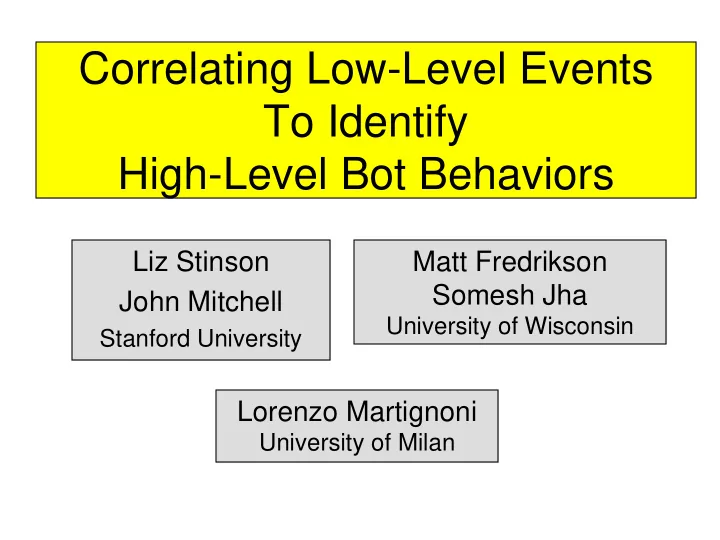

Correlating Low-Level Events To Identify High-Level Bot Behaviors Liz Stinson Matt Fredrikson Somesh Jha John Mitchell University of Wisconsin Stanford University Lorenzo Martignoni University of Milan
Our anti-inspirations • “Personal firewalls”: identify when an app is Too ambiguous connecting to the network • Host-level methods that inundate us with information (all registry accesses/changes, Too noisy; devoid of meaning file accesses/changes) without providing a higher-level assessment of what’s going on
Problem Statement • >5M “distinct, active” bot-infected machines detected between January - June, 2007 – “active”: carried out at least one attack – Symantec Threat Report, Volume XII • The *best* anti-virus signature scanners fail to detect anywhere from 30% to 50% of malware samples seen in the wild – NB: The best AV scanners may not be who you think they are…
Problematic Asymmetry Malware writers know they have the work(create_sig) >> work(create_variant) advantage here and they exploit it. • AV companies decide which undetected Tens of thousands of novel malware to create sigs for using triage; must malware variants created annually exceed some prevalence threshold
Existing behavior-based detection • Identify simple, mostly stateless “features” May identify incidental , rather (process execution characteristics); e.g. than fundamental behaviors – Which dir(s) does app live in? write to? App = shadow? – App survives reboot? Spawns/terminates other For ML-based approaches, may be processes? Is orphan? Hides? Its image has changed? � Traits malware have adapted to evade AV detect other ways to achieve same end (i.e. ways not included in model) • Statefully scan network packet contents • More general characterizations – Abstract: spyware monitors/reports user actions – Concrete: rootkits that load kernel modules
Broad spectrum. How to evaluate? • How effectively does this method distinguish malicious behavior from benign? • How thoroughly is target behavior captured? • How complex is the identified behavior? • How fundamental is the behavior to the malware’s purpose?
Goals • We want to identify high-level behaviors Sample bot commands – “downloading and executing a program” – “acting like a TCP server” http.execute <URL> <local_path> – “acting like a proxy” harvest.registry <reg_key> redirect <lport> <rhost> <rport> – “leaking sensitive data” startkeylogger • Bot-command-level actions • Via monitoring process execution • Distinguish malicious from benign instances of above by identifying if remotely initiated
tcp connection Example: Acting like a proxy tcp connection
Identifies ordering dependencies Not shown here edge constraints die operations socket duplication intervening irrelevant ops
Including parameters and constraints Constraints can be pre-conditions or post-conditions
tcp_client
We’ll focus on this Refining
(send_buf == recv_buf) • Too constrained; really want to express: the buffer that is sent is derived from a buffer that is received • Augment (add action to): on_match of net_recv set_tainted( recv_buf, sd2 /*taint label*/ ) • Change condition to: tainted( send_buf, sd2 /*taint label*/ )
Modified graph
.redirect <loc_port> <rem_host> <rem_port> Add constraints
“Language” our system exports • Set of high-level primitives that can be combined to describe interesting behaviors – tcp_client , tcp_server , net_send , net_r ecv , create_exec_file , … • Using these, we can detect: – Leak private data (reg key values, file contents, system info, …) – Download and execute a program – Send email – Proxy – Keystroke logging
Challenges • Posed by proprietary-OS environment – Opacity; identifying operations & constraints – Replicating OS semantics • Posed by syscall interposition generally • Posed by hypothetical attempts to evade – Split behavior across processes or across runs of the same application – Expropriate kernel functionality • e.g. raw sockets
Summary � Target the behaviors that make bots useful � Identify the essential ops in those behaviors � Use data-flow analysis info variously � Good initial results against bots o Including: rbot, agobot, dsnxbot, spybot, ... o Use bot commands as inspiration o Resilient to encryption of bot communications � Good initial results against benign progs o When testing against specifications that encode remote-control requirement o Performing user-input tracking
Recommend
More recommend